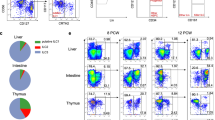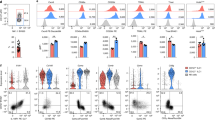Abstract
The precise lineage relationship between innate lymphoid cells (ILCs) and lymphoid tissue–inducer (LTi) cells is poorly understood. Using single-cell multiplex transcriptional analysis of 100 lymphoid genes and single-cell cultures of fetal liver precursor cells, we identified the common proximal precursor to these lineages and found that its bifurcation was marked by differential induction of the transcription factors PLZF and TCF1. Acquisition of individual effector programs specific to the ILC subsets ILC1, ILC2 and ILC3 was initiated later, at the common ILC precursor stage, by transient expression of mixed ILC1, ILC2 and ILC3 transcriptional patterns, whereas, in contrast, the development of LTi cells did not go through multilineage priming. Our findings provide insight into the divergent mechanisms of the differentiation of the ILC lineage and LTi cell lineage and establish a high-resolution 'blueprint' of their development.
This is a preview of subscription content, access via your institution
Access options
Subscribe to this journal
Receive 12 print issues and online access
$209.00 per year
only $17.42 per issue
Buy this article
- Purchase on Springer Link
- Instant access to full article PDF
Prices may be subject to local taxes which are calculated during checkout







Similar content being viewed by others
Accession codes
References
Diefenbach, A., Colonna, M. & Koyasu, S. Development, differentiation, and diversity of innate lymphoid cells. Immunity 41, 354–365 (2014).
Serafini, N., Vosshenrich, C.A. & Di Santo, J.P. Transcriptional regulation of innate lymphoid cell fate. Nat. Rev. Immunol. 7, 1217–1224 (2015).
Klose, C.S. et al. A T-bet gradient controls the fate and function of CCR6-RORγt+ innate lymphoid cells. Nature 494, 261–265 (2013).
Huang, Y. et al. IL-25-responsive, lineage-negative KLRG1hi cells are multipotential 'inflammatory' type 2 innate lymphoid cells. Nat. Immunol. 16, 161–169 (2015).
Constantinides, M.G., McDonald, B.D., Verhoef, P.A. & Bendelac, A. A committed precursor to innate lymphoid cells. Nature 508, 397–401 (2014).
Klose, C.S. et al. Differentiation of type 1 ILCs from a common progenitor to all helper-like innate lymphoid cell lineages. Cell 157, 340–356 (2014).
Yu, X. et al. The basic leucine zipper transcription factor NFIL3 directs the development of a common innate lymphoid cell precursor. eLife 3, e04406 (2014).
Xu, W. et al. NFIL3 orchestrates the emergence of common helper innate lymphoid cell precursors. Cell Rep. 10, 2043–2054 (2015).
Seillet, C. et al. Nfil3 is required for the development of all innate lymphoid cell subsets. J. Exp. Med. 211, 1733–1740 (2014).
Seehus, C.R. et al. The development of innate lymphoid cells requires TOX-dependent generation of a common innate lymphoid cell progenitor. Nat. Immunol. 16, 599–608 (2015).
Hoyler, T. et al. The transcription factor GATA-3 controls cell fate and maintenance of type 2 innate lymphoid cells. Immunity 37, 634–648 (2012).
Serafini, N. et al. Gata3 drives development of RORγt+ group 3 innate lymphoid cells. J. Exp. Med. 211, 199–208 (2014).
Yagi, R. et al. The transcription factor GATA3 is critical for the development of all IL-7Rα-expressing innate lymphoid cells. Immunity 40, 378–388 (2014).
Yang, Q. et al. T cell factor 1 is required for group 2 innate lymphoid cell generation. Immunity 38, 694–704 (2013).
Mielke, L.A. et al. TCF-1 controls ILC2 and NKp46+RORγt+ innate lymphocyte differentiation and protection in intestinal inflammation. J. Immunol. 191, 4383–4391 (2013).
Moro, K. et al. Innate production of TH2 cytokines by adipose tissue-associated c-Kit+Sca-1+ lymphoid cells. Nature 463, 540–544 (2010).
Wong, S.H. et al. Transcription factor RORα is critical for nuocyte development. Nat. Immunol. 13, 229–236 (2012).
Spooner, C.J. et al. Specification of type 2 innate lymphocytes by the transcriptional determinant Gfi1. Nat. Immunol. 14, 1229–1236 (2013).
Walker, J.A. et al. Bcl11b is essential for group 2 innate lymphoid cell development. J. Exp. Med. 212, 875–882 (2015).
Moro, K. & Koyasu, S. Innate lymphoid cells, possible interaction with microbiota. Semin. Immunopathol. 37, 27–37 (2015).
Cherrier, M., Sawa, S. & Eberl, G. Notch, Id2, and RORγt sequentially orchestrate the fetal development of lymphoid tissue inducer cells. J. Exp. Med. 209, 729–740 (2012).
Constantinides, M.G. et al. PLZF expression maps the early stages of ILC1 lineage development. Proc. Natl. Acad. Sci. USA 112, 5123–5128 (2015).
Tachibana, M. et al. Runx1/Cbfβ2 complexes are required for lymphoid tissue inducer cell differentiation at two developmental stages. J. Immunol. 186, 1450–1457 (2011).
Aliahmad, P., de la Torre, B. & Kaye, J. Shared dependence on the DNA-binding factor TOX for the development of lymphoid tissue-inducer cell and NK cell lineages. Nat. Immunol. 11, 945–952 (2010).
Yokota, Y. et al. Development of peripheral lymphoid organs and natural killer cells depends on the helix-loop-helix inhibitor Id2. Nature 397, 702–706 (1999).
Malhotra, N. et al. A network of high-mobility group box transcription factors programs innate interleukin-17 production. Immunity 38, 681–693 (2013).
Ramirez, K. et al. Gene deregulation and chronic activation in natural killer cells deficient in the transcription factor ETS1. Immunity 36, 921–932 (2012).
Halim, T.Y. et al. Retinoic-acid-receptor-related orphan nuclear receptor α is required for natural helper cell development and allergic inflammation. Immunity 37, 463–474 (2012).
Bando, J.K., Liang, H.E. & Locksley, R.M. Identification and distribution of developing innate lymphoid cells in the fetal mouse intestine. Nat. Immunol. 16, 153–160 (2015).
Zhu, J., Yamane, H. & Paul, W.E. Differentiation of effector CD4 T cell populations. Annu. Rev. Immunol. 28, 445–489 (2010).
van de Pavert, S.A. et al. Maternal retinoids control type 3 innate lymphoid cells and set the offspring immunity. Nature 508, 123–127 (2014).
Spencer, S.P. et al. Adaptation of innate lymphoid cells to a micronutrient deficiency promotes type 2 barrier immunity. Science 343, 432–437 (2014).
Neill, D.R. et al. Nuocytes represent a new innate effector leukocyte that mediates type-2 immunity. Nature 464, 1367–1370 (2010).
Laslo, P. et al. Multilineage transcriptional priming and determination of alternate hematopoietic cell fates. Cell 126, 755–766 (2006).
Hu, M. et al. Multilineage gene expression precedes commitment in the hemopoietic system. Genes Dev. 11, 774–785 (1997).
Miyamoto, T. et al. Myeloid or lymphoid promiscuity as a critical step in hematopoietic lineage commitment. Dev. Cell 3, 137–147 (2002).
Ng, S.Y., Yoshida, T., Zhang, J. & Georgopoulos, K. Genome-wide lineage-specific transcriptional networks underscore Ikaros-dependent lymphoid priming in hematopoietic stem cells. Immunity 30, 493–507 (2009).
Antebi, Y.E. et al. Mapping differentiation under mixed culture conditions reveals a tunable continuum of T cell fates. PLoS Biol. 11, e1001616 (2013).
Satoh-Takayama, N. et al. The chemokine receptor CXCR6 controls the functional topography of interleukin-22 producing intestinal innate lymphoid cells. Immunity 41, 776–788 (2014).
Acknowledgements
We thank J.C. Zúñiga-Pflücker (University of Toronto) for stocks of OP9 and OP9-DL1 stromal cells. Supported by the US National Institutes of Health (R01 HL118092, AI038339 and AI108643) and by the Digestive Diseases Research Center of Excellence (P30DK42086).
Author information
Authors and Affiliations
Contributions
I.E.I., H.G., M.G.C. and A.B. designed the experiments; I.E.I. performed single-cell sorting and culture experiments; S.C. designed and performed the lymphoid Biomark assay; H.G. performed computational analysis of the Biomark experiments; M.G.C. designed and performed experiments; A.R.D. supervised computational analysis; A.B. supervised experiments; R.G. supervised Biomark experiments; and I.E.I., H.G. and A.B. wrote the manuscript with contributions from all authors.
Corresponding author
Ethics declarations
Competing interests
The authors declare no competing financial interests.
Integrated supplementary information
Supplementary Figure 1 Intercellular transcriptional distances confirm hierarchical clustering analysis.
Euclidean distance between all pairs of measured transcriptional profiles. Dendrograms shown are those obtained from the hierarchical clustering of these intercellular distances. Outer bar, sorted cell type; αLP (red), ILCP (green), LTiP (blue). Inner bar, cluster assignment of each cell; AI-III (red), B (purple), CI-IV (green).
Supplementary Figure 2 α4β7+IL-33Rαhi cells represent contaminating mast cell precursors.
a, Biomark analysis of the Il33r+ cluster excluded from the study suggested that they were not innate lymphoid cells, as evidenced by the nearly uniform lack of Tcf7 and Tox, as well as other key markers. b, FACS analysis suggested the mast cell nature of these cells. α4β7-MACS-enriched fetal liver cells obtained from the Zbtb16-GFPCre reporter strain were gated as Lin− cells (this is the same population that was used to sort single αLP and ILCP) and stained for IL-33Rα. The IL-33Rα+ cells expressed intermediate amounts of PLZF (GFP) and α4β7, possibly explaining why they were found as contaminants in the Biomark analysis of ‘purified’ αLP and ILCP. 16% of these cells expressed the mast cell marker FcεRIα, indicating that they were mast cell lineage precursors.
Supplementary Figure 3 Expression frequencies of key transcription factors in αLP and ILCP transcription-state clusters define their developmental progression.
In each cluster, the proportion of cells with detectable levels of transcript is calculated for genes defining early developmental transitions. Similar to the trends observed in average transcript levels by cluster, Id2 is first expressed at a low level in AI, followed by Tox and Nfil3 in AII, Sox4 and Runx1 in AIII, and finally by Tcf7 and Zbtb16 in B.
Supplementary information
Supplementary text and figures
Supplementary Figures 1–3 and Supplementary Tables 1 and 2 (PDF 655 kb)
Rights and permissions
About this article
Cite this article
Ishizuka, I., Chea, S., Gudjonson, H. et al. Single-cell analysis defines the divergence between the innate lymphoid cell lineage and lymphoid tissue–inducer cell lineage. Nat Immunol 17, 269–276 (2016). https://doi.org/10.1038/ni.3344
Received:
Accepted:
Published:
Issue Date:
DOI: https://doi.org/10.1038/ni.3344
This article is cited by
-
Lymphoid tissue inducer cells in cancer: a potential therapeutic target
Molecular and Cellular Biochemistry (2023)
-
Innate lymphocytes: pathogenesis and therapeutic targets of liver diseases and cancer
Cellular & Molecular Immunology (2021)
-
Building early defenses
Cell Research (2021)
-
The interplay between innate lymphoid cells and T cells
Mucosal Immunology (2020)
-
ACC1 determines memory potential of individual CD4+ T cells by regulating de novo fatty acid biosynthesis
Nature Metabolism (2019)



